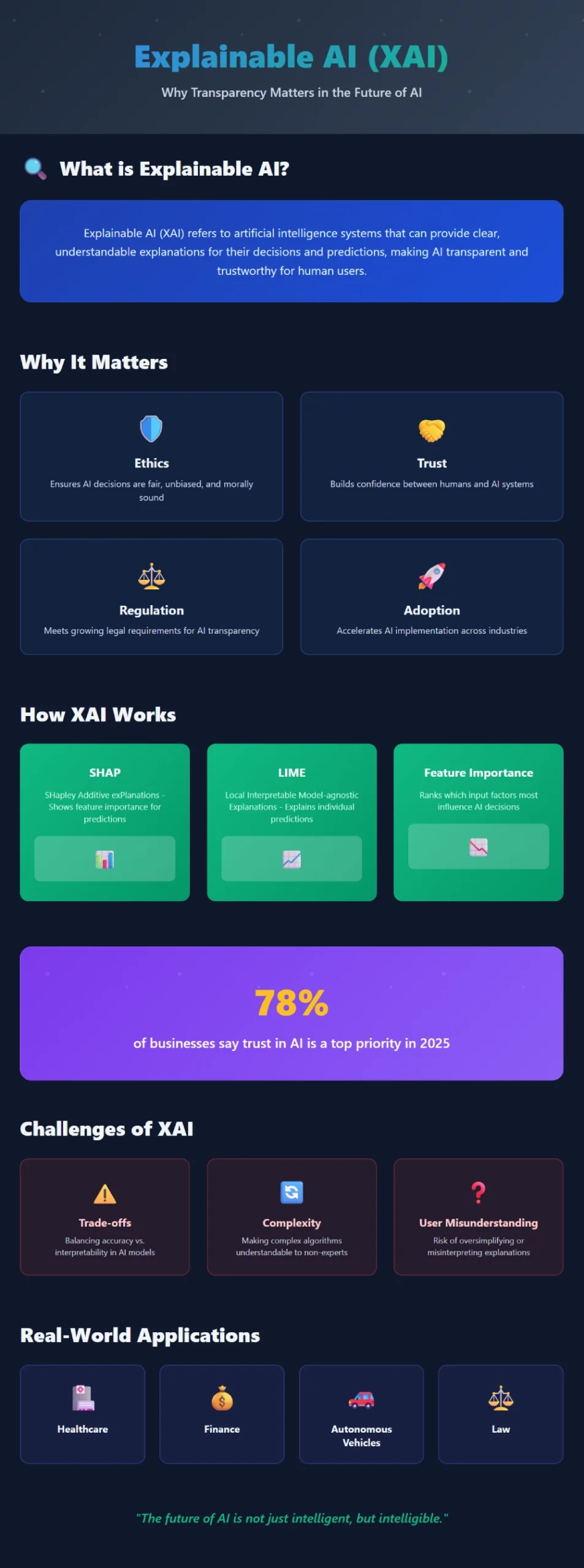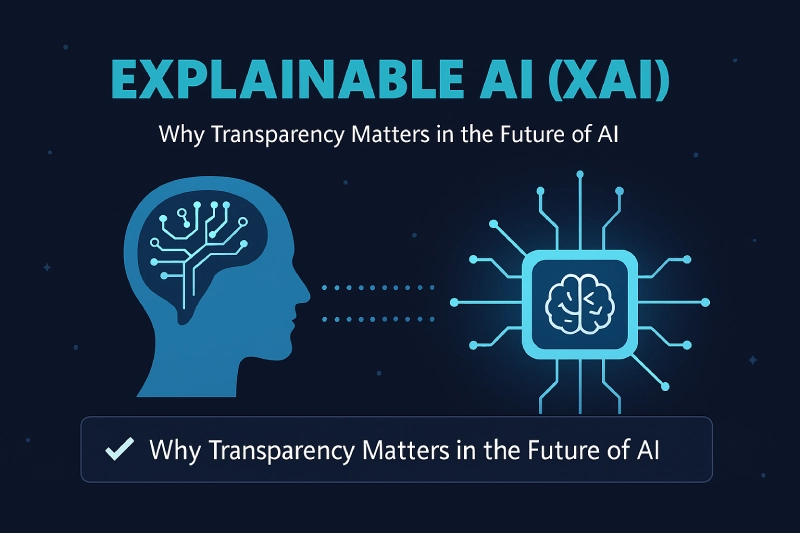Explainable AI (XAI) makes artificial intelligence systems easier to understand by showing how they reach decisions. This transparency builds trust, ensures fairness, and helps businesses and regulators confidently adopt AI without fearing hidden “black box” risks.
What is Explainable AI (XAI)?
Explainable AI, often shortened to XAI, refers to methods and tools that make AI decision-making understandable to humans. Instead of treating AI models like mysterious black boxes, XAI explains the “why” behind predictions, classifications, or recommendations.
Think of it like a teacher showing their work on the board—rather than just giving the answer, they outline the reasoning step by step. This is critical when AI influences important areas like healthcare diagnoses, financial approvals, or self-driving car navigation.
At its core, XAI supports AI interpretability, AI transparency, and ethical AI, making sure machines don’t just deliver results but also reveal how they got there.
Why Transparency in AI Matters
Transparency in AI isn’t just a technical nice-to-have; it’s the foundation for ethical adoption and long-term trust. Without explanations, AI risks being rejected or even regulated out of use.
Building User Trust
When users can see why AI recommends a treatment, approves a loan, or flags content, they are far more likely to trust the system. Imagine applying for a mortgage: would you accept a flat “denied” without explanation? Probably not. XAI gives people confidence that AI isn’t acting arbitrarily.
Meeting Ethical & Legal Standards
Governments and regulators are tightening rules around ethical AI. The EU’s AI Act, for instance, stresses explainability as a legal requirement for high-risk AI systems. Without AI transparency, organizations could face lawsuits, fines, or reputational damage.
Driving Adoption in Business
For businesses, XAI isn’t just about compliance—it’s also about ROI. When managers and employees understand how AI models work, they’re more likely to adopt them in day-to-day workflows. In industries like finance and insurance, explainability often makes the difference between rolling out an AI system or shelving it.
How Explainable AI Works
Explainable AI relies on interpretability methods that shed light on how models behave. Let’s break down the most common approaches.
SHAP (Shapley Additive Explanations)
SHAP values assign a contribution score to each feature in a model. It’s like asking: how much did this factor matter in the final decision? For example, in a credit scoring model, SHAP might reveal that “income level” contributed 60% to the approval, while “payment history” added 30%.
LIME (Local Interpretable Model-agnostic Explanations)
LIME explains individual predictions by building a simpler, interpretable model around a single instance. Imagine asking, “Why did the AI think this specific photo was a cat?” LIME highlights local features—like fur texture or ear shape—that influenced the decision.
Feature Importance & Visualization
Sometimes, simple visualization works best. Bar charts, heatmaps, or feature importance rankings show which inputs the AI model weighs most heavily. This makes it easier for non-technical users to see the reasoning, like a weather app explaining that humidity and temperature were the main drivers of its forecast.
Challenges of Explainable AI
While XAI is promising, it’s not without hurdles.
- Trade-off with Accuracy: The most accurate models (like deep neural networks) are often the least interpretable.
- Complexity of Explanations: Too much detail can overwhelm end users, defeating the purpose of explainability.
- Risk of Misinterpretation: Simplified explanations may create false confidence if users think they fully understand a complex system.
Striking the right balance—clear, useful, but accurate explanations—is the real challenge.
Real-World Applications of XAI
Explainable AI is already reshaping key industries where stakes are high.
- Healthcare: Doctors can use XAI to understand why an algorithm recommends a treatment plan. For example, an AI model might explain that a patient’s lab results and genetic markers were primary decision factors.
- Finance: Banks employ XAI to justify credit approvals or fraud alerts. A flagged transaction might be explained by location, unusual spending patterns, or device type.
- Autonomous Vehicles: Self-driving cars use XAI to justify critical actions, like braking or lane changes. Transparency helps engineers debug issues and regulators assess safety.
- Law: In legal analytics, XAI clarifies why certain precedents or arguments were prioritized in predicting case outcomes. This ensures that legal decisions aren’t blindly influenced by opaque algorithms.
Future Outlook: XAI in the Next 5 Years
The next five years will likely see XAI shift from optional to mandatory. As trust in AI becomes a business differentiator, customers will expect transparency as a baseline. Regulations will further drive adoption.
We may also see standardized XAI frameworks emerge, much like accounting standards, making it easier to audit and certify AI systems. By 2030, organizations that can’t explain their AI may find themselves losing customers—or even market access.

Share this infographic on your website by pasting the code below. Don’t forget to give proper credit to SanishTech with a backlink.
How Developers & Businesses Can Implement XAI Today
Getting started with explainable AI doesn’t mean rebuilding your entire tech stack. Practical steps include:
- Choose Interpretable Models Where Possible: For non-critical tasks, simpler models (like decision trees) may be more transparent than complex deep learning.
- Integrate SHAP or LIME: These tools can be plugged into many popular machine learning frameworks like TensorFlow or PyTorch.
- Create User-Friendly Dashboards: Don’t just show raw data; visualize results so non-technical stakeholders can understand them.
- Align with Ethical AI Guidelines: Follow frameworks like Google’s Responsible AI or the EU’s AI Act draft.
On SanishTech, you’ll also find tools and resources to explore how transparency can complement data-driven workflows.
Conclusion & Call to Action
Explainable AI is more than a buzzword—it’s the bridge between powerful algorithms and human trust. Without transparency, even the most advanced AI systems risk being sidelined. With it, industries can unlock innovation while ensuring fairness, accountability, and adoption.
If you found this guide useful, share it with your network or embed our upcoming XAI infographic (with credit to SanishTech) to spread awareness about why transparency matters in the future of AI.



